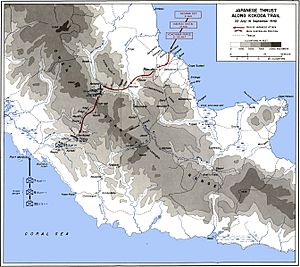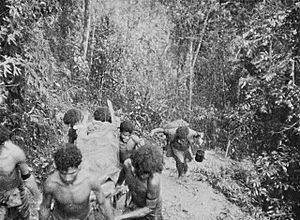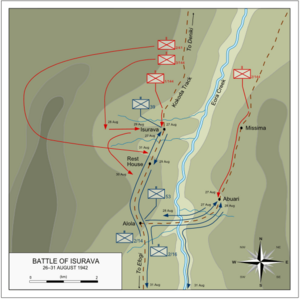Battle of Isurava facts for kids
Quick facts for kids Battle of Isurava |
|||||||
|---|---|---|---|---|---|---|---|
| Part of the Second World War, Pacific War | |||||||
 Members of the 39th Battalion withdrawing after the Battle of Isurava |
|||||||
|
|||||||
| Belligerents | |||||||
| Commanders and leaders | |||||||
| Units involved | |||||||
|
Maroubra Force
|
South Seas Detachment
|
||||||
| Strength | |||||||
| 2,290 | 2,130 | ||||||
| Casualties and losses | |||||||
| 99 killed 111 wounded |
140 killed 231 wounded |
||||||
The Battle of Isurava was a major fight during the Kokoda Track campaign in World War II. It happened from August 26 to 31, 1942. Australian and American forces fought against Japanese troops in Papua New Guinea. The Japanese wanted to capture Port Moresby by marching over land.
Before Isurava, there were smaller battles north of Kokoda. Australian soldiers, part of a group called Maroubra Force, tried to slow down the Japanese. After more fighting, the Australians pulled back to Isurava. Here, they were joined by experienced Australian soldiers from the 21st Infantry Brigade.
This battle was the first big clash of the campaign. Four Australian battalions fought against a similar number of Japanese soldiers. The Australians defended their positions for four days. They faced heavy Japanese artillery fire without having their own. Eventually, they had to retreat towards Templeton's Crossing.
Even though the Japanese won the battle, it became a very important part of Australia's war story. Early accounts said the Australians, though outnumbered, caused more damage than they took. This showed their bravery and became part of the Anzac legend. More recent studies show that Australian soldiers were very brave. They also suggest that Japanese mistakes helped the Australians retreat safely.
Contents
Setting the Scene: The Kokoda Track
The Land Around Isurava
The Kokoda Track is a long, difficult path in Papua New Guinea. It stretches about 96 kilometers (60 miles) through the Owen Stanley Range. This mountain range separates the northern coast from the southern coast. In 1942, the land was very challenging for soldiers. Both sides didn't fully understand how tough it would be.
The track goes up and down a lot, making it hard to travel. The area is mostly dense jungle, hot, and humid. Higher up, it can get cold. Near the coast, there are thick grasses and swamps, and many soldiers got sick with malaria.
Isurava is a clearing on a mountain peak along the track. It's south of Deniki and north of Alola. A rest house was nearby, offering views of the Eora Valley. To the east, the land drops steeply into a deep valley with the fast-flowing Eora Creek.
Isurava was on a ridge that went west towards Eora Creek. Two small streams cut across the track near it. On the other side of Eora Creek was Missima village. This village was on a smaller path that joined the main Kokoda Track. Isurava was not the best place to defend. A ridge to its north allowed Japanese artillery to fire down on the Australian positions.
Why Port Moresby Was Important
Port Moresby was a very important place for both sides. It was a base from which they could launch more attacks. After the Japanese failed to attack Port Moresby by sea, they decided to march over land.
On July 21, 1942, Japanese forces landed on the northern coast of Papua. They wanted to capture Port Moresby by crossing the Owen Stanley Range. Australian and Papuan forces tried to slow them down. The Australians needed more supplies and experienced soldiers. It was hard to get these supplies to the front lines.
The Japanese advanced steadily. There were small fights along the way. Australian and Papuan soldiers were forced back to Deniki. Then, a small group tried to hold Kokoda village and its important airfield. After heavy fighting, the Australians retreated to Isurava on August 14.
At the same time, on August 7, US forces landed on Guadalcanal. This surprised the Japanese. They had to send some of their soldiers, who were meant for Papua, to Guadalcanal instead. This made the Japanese leaders rethink their plan for Port Moresby. They decided to postpone capturing Port Moresby until the situation at Guadalcanal was better.
The Soldiers Fighting
On August 17, Lieutenant Colonel Ralph Honner took command of the 39th Infantry Battalion at Isurava. The 39th Battalion was made up of Militia soldiers. They were later joined by two experienced battalions from the Second Australian Imperial Force (2nd AIF). These were the 2/14th and 2/16th Infantry Battalions. They were led by Brigadier Arnold Potts.
The 21st Infantry Brigade had fought in the Middle East. But they had not fought in jungle conditions before. Potts was first ordered to retake Kokoda. But when the Australians realized how many Japanese there were, and how few supplies they had, the plan changed. Potts was ordered to defend Isurava to stop the Japanese advance.
The Australians had about 2,292 soldiers in total. This included the 53rd Infantry Battalion and support units. The soldiers were tired from the jungle warfare. They had limited food, poor equipment, and many were getting sick. The Australians did not have artillery support at Isurava. They only had one mortar, which arrived during the battle.
The Japanese force was led by Major General Tomitaro Horii. It had four infantry battalions, mostly from the 144th Infantry Regiment. They also had engineers and artillery. Some estimates say the Japanese had around 3,000 to 3,500 soldiers. Only about 2,130 were directly involved in the battle.
Many Japanese soldiers did not reach Isurava in time for the battle. This was because of the heat, heavy loads, and long march. Horii planned to attack the Australians from both sides.
Both sides had problems getting supplies. The Australians tried to use planes to drop supplies. But this was a new method and often didn't work well. Supplies were damaged or fell in the wrong places. This made it hard to bring in Australian reinforcements quickly.
The Battle of Isurava
Japanese Attack Begins
The 39th Battalion was spread out in five areas around Isurava. They had to dig their positions using whatever they could find, like helmets. Their spots were in tall grass, giving them a good view of the track. The 53rd Infantry Battalion was further back at Alola.
On August 24 and 25, Japanese patrols clashed with Australian groups. Potts realized a big attack was coming. He sent the 2/14th Battalion to Isurava. The 39th Battalion helped cover their movement. The 2/16th Battalion was kept in reserve at Alola.
On August 26, the Japanese attack began. Australian positions were hit by heavy artillery fire. The Japanese tried to pin the Australians down with attacks from the front. At the same time, they tried to go around the sides to cut off the Australians.
One Japanese battalion attacked the front. Another went to the eastern side of Eora Creek. Their goal was to get behind the Australians at Alola. A third Japanese battalion tried to go around the Australian left side.
The Japanese broke through the 53rd Battalion's position around Missima. This opened a path to the Australian rear. The 53rd's commander was killed, and their position fell apart. However, the Japanese did not fully use this chance. They were tired and thought the area was more heavily defended. The 2/16th Battalion was sent to help the 53rd.
Meanwhile, the Australian outpost on the left side held on. But as the Japanese started to go around them, they had to pull back. Then, the Japanese began direct attacks on the main Australian positions. This started four days of fierce fighting. The Japanese used mountain guns and mortars. The Australians held their ground, firing only when the enemy was very close.
On August 27, the 39th Battalion moved behind the 2/14th Battalion. Intense close-quarters fighting continued. Probing attacks by the Japanese went on through the night.
Heroism and Retreat
On August 28, the fighting continued. The Japanese made a brief breakthrough, but the Australians quickly pushed them back. The Japanese commander realized the Australians had reinforcements. He decided to send in his reserves. One Japanese battalion tried to go around the Australian main position from the west. But they got lost in the thick jungle. Another Japanese battalion also got lost and did not even fire a shot in the battle.
On August 29, the Japanese attacked again. They had control of the ridges, so they could fire down on the Australians. The Australian defenses began to shrink. During this time, Private Bruce Kingsbury of the 2/14th Battalion showed incredible bravery. He charged at the Japanese with a machine gun, breaking their attack. He was killed but was awarded the Victoria Cross, Australia's highest military honor. This was the first Victoria Cross awarded for actions on Australian soil.
The Australian positions were becoming impossible to hold. The commander of the 2/14th asked to pull back to the Isurava rest house. This was about 1 kilometer (0.6 miles) back. They completed the retreat by the morning of August 30. The Japanese brought up more artillery and heavily shelled the new Australian position.
Japanese soldiers also found their way to the Australian flank and rear. Hand-to-hand fighting broke out. With many casualties and low ammunition, the Australians were in danger of being surrounded. Brigadier Potts decided that staying would mean his forces would be destroyed. So, he ordered a full retreat south towards Eora village.
The 39th and 2/14th Battalions pulled back along the track. The 2/16th withdrew along the eastern side of Eora Creek. During the retreat, some Australian groups got separated. In the confusion, an Australian counter-attack accidentally caught some of their own troops in crossfire. Many soldiers had to trek through the jungle for days to rejoin their units. Some were captured by the Japanese.
After the Battle
Continued Fighting and Retreat
After the battle, the Australians retreated towards Eora Creek. The Japanese occupied Alola, where they found much-needed supplies. On August 28, Horii had been ordered to hold his main force north of the Owen Stanleys. This was because of the situation at Guadalcanal. So, he sent only about 3,500 men to chase the Australians.
For about a week after Isurava, the Australians fought a "fighting withdrawal." More battles happened at Templeton's Crossing and Efogi in early September. The Australian resistance became stronger. The tired 39th and 53rd Battalions were sent back to Port Moresby. The 2/27th Battalion joined the 21st Infantry Brigade for the fighting at Efogi.
While the battle at Isurava was happening, the Japanese also tried to land troops at Milne Bay. But this attack failed. This was the first time the Japanese suffered a big defeat on land. This defeat, along with the fighting at Guadalcanal, affected the Japanese on the Kokoda Track.
On September 8, Horii was ordered to pull back towards Kokoda. The Japanese supply line was very stretched. Their soldiers were tired and hungry. Still, Horii continued his advance south for a short time. Another battle was fought at Battle of Ioribaiwa, about 40 kilometers (25 miles) from Port Moresby.
The Australians then pulled back to their final defensive line at Imita Ridge. But there was no big battle there. Horii finally stopped his attack on September 14. He began to withdraw north to get more supplies for his troops. The Australians then started chasing the Japanese. More battles were fought at Templeton's Crossing and around Oivi and Gorari in October. The Japanese retreated across the Kumusi River to their bases near Buna and Gona. Heavy fighting happened there in late 1942 and early 1943.
|






